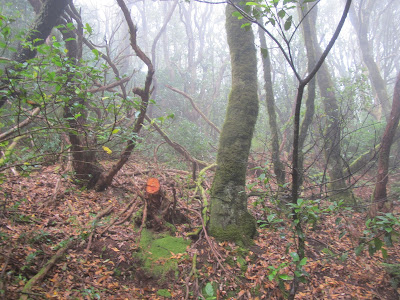Our Exploration of The Forest
nearby Líský The Settlement (VI)
(7.30. 2016, the forest nearby Líský the settlement)
 |
| The Fig.1: Small bushes of blue berries grew in dense fields not too far from the main sylvan path dividing the forest into two parts. 7.30. 2016. Taken with my smart phone. |
Several Shots of The Forest
 |
| The Fig.2: A dense net of Calluna vulgaris (the heather in English) growing on the sylvan path on the fig.3. 7.30. 2016. Taken with my smart phone. |
As I have already written we took our way back to Líský the settlement through the right part of the forest. While its left part (with our backs to the lookout and the settlement behind it) brought some findings of orchids, though in fruit only (two or three species of Epipactis the genus), its right part showed us various elements but the orchids. In fact, in this phase of our return with our faces at the direction of the lookout and the settlement behind it the right part of the forest changed in its left part.
So much for your orientation.
 |
| The Fig.3: Stubs next to the sylvan path were decorated with this mushroom, maybe it was Trametes versicolor. 7.30. 2016. Taken with my smart phone. |
Well then, walking through now the left section of the forest, first we went deeper in it, i.e. further from the sylvan path we had come to the habitat of the orchids. This sylvan path divided the forest into the two parts. It was our point of orientation in the terrain.
 |
| The Fig.4.: Fagus sylvatica (beech in English) in fruit at an edge of the right (in that moment) part of the forest. 7.30. 2016. Taken with my Canon. |
During our way through the forest I could observe something what I called a tired vegetation, i.e. the vegetation in fruit, lesser in flower in this yearly season.
 |
| The Fig.5: Larix decidua (a larch in English) in fruit at the same edge of the right part of the forest as it is on the picture 4. 7.30. 2016. taken with my Canon. |
Gradually we were turning back to the main sylvan path. By this way we returned to Líský the settlement where Vendy´s car waited for us. We took a short rest on a low wall next to the car. We were going to explore last habitat in the surroundings of Líský the settlement.
 |
| The Fig.6: There was an oak, too, in the species composition of the forest. I suppose that this is Quercus robur. 7.30. 2016. Taken with my Canon. |
The Czech Version
Náš průzkum lesa poblíž osady Líský (VI)
(30.7. 2016, les opodál osady Líský)
Několik snímků lesa
 |
| The Fig.8: The forest from inside. Its herbaceous floor was abundant in various species of plants. 7.30. 2016. Taken with my smart phone. |
Jak už jsem napsal, zvolili jsme zpáteční cestu do osady Líský přes pravou část lesa. Zatímco levá část (se zády k rozhledně a osadě za ní) přinesla nějaké nálezy orchidejí, i když jen v plodu (dva či tři druhy rodu kruštík (Epipactis)), jeho pravá část nám ukazovala různé prvky kromě orchidejí. Ve skutečnosti se v této fázi našeho návratu s tvářemi ve směru rozhledny a osady za ní jeho pravá část změnila v levou.
Tolik pro vaši orientaci.
Jak jsme tedy procházeli teď už levou částí lesa, zprvu jsme do něj zacházeli hlouběji, tj. od lesní cesty, kterou jsme na lokalitu orchidejí přišli. Tato lesní cesta dělila les ve dvě části. Byl to náš orientační bod v terénu.
Během cesty lesem jsem mohl pozorovat cosi, čemu říkám unavená vegetace, tj. vegetace v plodu, méně v květu v tomto ročním období.
Postupně jsme se stáčeli zpět k hlavní lesní cestě. Tou jsme se vraceli zpět do vesnice Líský, kde na nás čekalo Vendovo auto. Krátce jsme si odpočali na nízké zídce vedle auta. Chystali jsme se prozkoumat poslední lokalitu v okolí osady Líský.
Česká verze popisků pod obrázky:
Obr:1: Keříčky borůvek rostly v hustých polích nepříliš daleko od hlavní lesní cesty dělící les na dvě části. 30.7. 2016. Pořízeno mým chytrým mobilem.
Obr.2: Hustá síť vřesu obecného (Calluna vulgaris) rostoucí na lesní cestě na obr.3. 30.7. 2016. Pořízeno mým chytrým mobilem.
Obr.3: Pařezy lesní cesty zdobila tahle houba. Snad to byla outkovka pestrá (Trametes versicolor). 30.7. 2016. Pořízeno chytrým mobilem.
Obr.4: Buk lesní (Fagus sylvatica) v plodu při okraji pravé (v té chvíli) části lesa. 30.7. 2016. Pořízeno Canonem.
Obr.5: Modřín opadavý (Larix decidua) v plodu při stejném okraji pravé části lesa jako na obr.4. 30.7. 2016. Pořízeno Canonem.
Obr.6: V druhové skladbě lesa byl také dub. Předpokládám, že tohle je dub letní (Quercus ruber). 30.7. 2016. Pořízeno Canonem.
Obr.7: V jednu chvíli jsme se ocitli na lesní cestě porostlé nízkou vegetací. Cesta se moc nepoužívala. Vidíte, že les byl smíšený. Skládal se z jehličnanů a listnáčů. 30.7. 2016. Pořízeno chytrým mobilem.
Obr.8: Les zevnitř. Jeho bylinné patro bylo hojné na různé rostlinné druhy. 30.7. 2016. Pořízeno chytrým mobilem.


























 T
T











